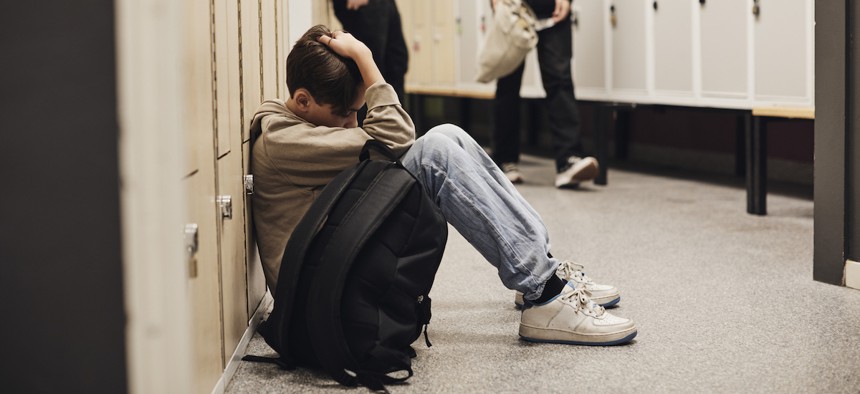Strained juvenile justice systems get relief from mobile behavioral health programs

Maskot/Getty Images
Community-based crisis intervention services are diverting adolescents with mental and behavioral health issues from the criminal justice system, which is unequipped to meet their needs.
Nationwide, a growing mental health crisis among adolescents has state and local leaders scrambling to stand up resources, programs and initiatives to offer younger residents the treatment and care they need.
While efforts like the 988 suicide and crisis hotline are seeing some success, residents still primarily turn to law enforcement agencies for a mental or behavioral health-related incident. Teachers and principals, too, often turn to school resource officers when children become too difficult to manage. As a result, what might have been a disciplinary matter escalates into an arrest with adolescents being referred to juvenile justice systems.
In 2019, for instance, a 6-year-old student in Orlando, Florida, was restrained with a zip tie, arrested, put into the back of a police car and charged with battery by a resource officer after an emotional episode in which she kicked a teacher. That same day, another 6-year-old was also arrested. Cases like this indicate law enforcement’s lack of expertise when it comes to mental and behavioral health care, said Jeff Vanderploeg, president and CEO of the Connecticut-based nonprofit Child Health and Development Institute, or CHDI.
That’s why, amidst a reported steep increase in feelings of persistent sadness and hopelessness among young people, experts are calling on state and local leaders to develop more effective first responses to mental and behavioral incidents like the one in Orlando.
A growing number of judges, policymakers and activists have “a real issue with the fact that kids who had behavioral health conditions, kids who had trauma exposure [or] kids who had difficult family lives” that could explain their disruptive behavior “[end] up on a bench in a courtroom,” Vanderploeg said.
One solution states and localities are implementing to reduce the number of children referred to the criminal justice system is mobile interventions.
For more than a decade, Connecticut's Department of Children and Families has been funding the Mobile Crisis Intervention Services program. Residents experiencing or witnessing a mental or behavioral crisis involving a child can call 211 or 988 and be referred to a local mental health professional. The program includes more than 150 behavioral health clinicians who respond to calls for service to deescalate sensitive situations and develop treatment plans. The service is free and available for users regardless of insurance coverage.
A 2022 CHDI report showed a steady increase in call volume over the last 10 years, despite a slight decrease during the pandemic. Between fiscal year 2021 and 2022, call volume increased by 26.4%. The mobile service is a key element in Connecticut’s School-Based Diversion Initiative, which aims to reduce juvenile justice involvement among youth with mental health needs. From 2009 to 2022, 73 schools implemented SBDI and saw on average a 29% reduction in court referrals.
The findings are encouraging given that it can take days and even months to get a child an appointment with a traditional mental or behavioral health care provider. “That’s a need that [the mobile crisis program] really fills,” Vanderploeg said. “The rationale is to meet people where they are and to bring treatment to them when and where they need it most.”
The program can especially be helpful for school staff members who see concerning adolescent behavior more frequently. Instead of teachers diverting class time to address a disruptive student or turning to a resource officer, Vanderploeg said, they can contact 211 or 988 for immediate help from a health care professional. Almost 200 schools in Connecticut have memorandums of agreement to coordinate behavioral health care with crisis intervention providers.
Mobile interventions can also save governments “a whole lot of money” as they can avoid the costs of incarceration, Vanderploeg said. According to the Justice Policy Institute, the average state cost to incarcerate a young person is $588 per day—or $214,630 per year. Community-based programs, however, could cost as little as $57 a day.
A number of states also offer mobile-based services to address mental and behavioral needs and divert adolescents from the criminal justice system.
Nevada, for instance, offers a similar program to Connecticut’s. Residents can call the Children’s Mobile Crisis Response Team to deescalate behavioral crises with the help of health care professionals. The team coordinates with local detention centers, schools and hospitals to offer additional health care services after the initial call for service.
And in New Jersey, young people up to the age of 21 can consult Mobile Response and Stabilization Services, a program under which professional clinicians respond to calls for mental and behavioral crises. Responders can give callers information on nearby psychiatric screening centers or relevant emergency services.
Ultimately, Vanderploeg said, mobile services can help state and local leaders support “better lives and better outcomes for [their citizens].”
Editor's note: This story was changed Sept. 18 to correct details about Connecticut's mobile crisis intervention program.






